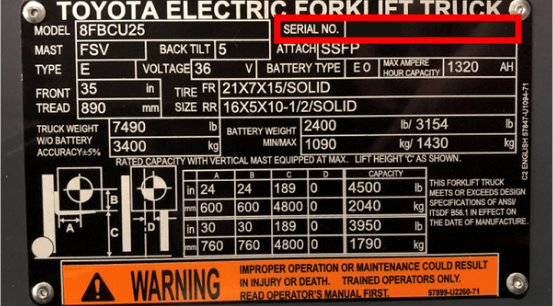10 Things You Learn In Toyota Forklift Operator Safety Training

Forklifts are used every day all over the world to move material and keep supply chains up and running. Nearly everything you see has come into contact with a forklift at some point along the way. The need to move things all over the country is why there are over 540,000 industrial truck operators employed in the United States.
Any individual who operates a forklift is required by the Occupational Safety and Health Administration (OSHA) to undergo forklift operator safety training and to be certified on every different type of forklift an operator drives. But what does this training entail? When you take an operator safety training course with Toyota, here are some of the things you’ll learn:
1. Who Can Operate a Forklift?
Only trained, qualified operators should ever operate a forklift.
2. The Difference Between Forklifts and Cars
Forklifts are different from automobiles. While at first glance it may not seem to be the case, a forklift weighs much more than a car or truck. The steer wheels are in the back meaning they steer differently. And there are occasionally uneven surfaces that might be encountered.
All forklift operators should be aware of the differences between operating a forklift versus operating an automobile and should implement safe operating practices accordingly.
3. How To Enter and Exit a Forklift
A three-point stance should be used when both entering and exiting a forklift. Two hands and one foot should be in contact with the forklift at all times. Additionally, having clean hands and shoes will further reduce the possibility of slips.
4. How to Read a Forklift Data Plate
All forklifts should have a legible, accurate data plate. For each special attachment, a data plate reflecting changes in load capacity should also be secured to the forklift.
Care should be taken by the operator to observe and follow the limitations listed on the data plate(s) including designated areas, lifting capacities, battery size, etc.
5. The Operation of a Loaded Versus an Unloaded Forklift
A loaded forklift is more stable than an unloaded forklift because of the change of location of the combined center of gravity.
6. The Role of Pedestrians In Safe Forklift Operation
Pedestrians play a role in forklift safety, just as operators do. Pedestrians should understand and be aware of the operating characteristics of forklifts as well as the environment they share with the forklifts.
They should always use designated walkways. It is also the responsibility of pedestrians to pay attention when passing through doorways and entering areas where forklifts travel and product is stacked, stored, or moved. Lastly, they should also make eye contact with the driver of the forklift. It should never be assumed that the pedestrian is seen by the operator.
7. The Necessity of Pre-Operation Forklift Inspections
It is required that all operators perform pre-operation inspections to identify that all forklift systems work properly before being placed into service. Engines, transmissions, brakes, mast and hydraulics, electrical systems, accessories, etc. should all be in working order. If not, the forklift should be tagged out/removed from service, and appropriate repairs should be made prior to operating the forklift.
8. How To Operate a Forklift on Ramps
Some forklifts should not be operated on ramps. Always refer to the appropriate forklift operator manual for instructions on correct ramp operation.
9. How Forklift Safety Is Reinforced
Each employer must designate a responsible person(s) to reinforce safety rules and practices as well as correct unsafe operator behavior.
10. More To Forklift Operator Safety Training Than Just a Test
While a test is involved in operator safety training, trainees will also watch formal training videos, be provided with visual aids, and participate in hands-on forklift demonstrations and supervised equipment operation. Each employer also has a responsibility to train forklift operators and pedestrians as to their particular environment and application where the forklift(s) will be used. Ideally, forklift operators should be evaluated in the actual environment where they will be using the forklift, such as their warehouse or distribution center.


